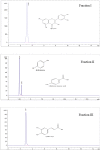Exploring the phenolic profile, antibacterial, and antioxidant properties of walnut leaves (Juglans regia L.)
- PMID: 37970415
- PMCID: PMC10630819
- DOI: 10.1002/fsn3.3554
Exploring the phenolic profile, antibacterial, and antioxidant properties of walnut leaves (Juglans regia L.)
Abstract
The aim of this study was to identify phenolic compounds in walnut leaves from northern Iraq and evaluate their ability to act as antibacterial and antioxidant agents. Phenolic compounds were determined by reversed-phase HPLC. Antibacterial activity was tested against various bacteria. Antioxidant properties were evaluated by various assays, including reducing power and DPPH radical scavenging activity. The HPLC profiles of walnut leaf fractions revealed quercetin, hydroquinone, 4-hydroxybenzoic acid, and caffeic acid in three fractions. The inhibitory activity of DPPH was determined as 47.66, 32.41, and 51.90 μg/mL for fractions I, II, and III, respectively. For ferric reducing power activity, fraction II > fraction III > fraction I and the FRAP activity was observed as 64.43, 73.19, and 68.18 μg/mL for fractions I, II, and III, respectively. All extracted fractions had antibacterial properties against all bacterial strains tested. Observations showed that fraction I was able to produce similar zones of inhibition as streptomycin in most cases. These results suggest that the fractions of this plant extract are plausible natural antioxidants that could be used as prime candidates for the synthesis of antioxidant drugs that can be used for the treatment of many oxidative stress-related diseases.
Keywords: caffeic acid; hydroquinone; quercetin; walnut.
© 2023 The Authors. Food Science & Nutrition published by Wiley Periodicals LLC.
Conflict of interest statement
The authors declare that they have no known competing financial interests or personal relationships that could have appeared to influence the work reported in this paper.
Figures
References
-
- Acquaviva, R. , D'Angeli, F. , Malfa, G. A. , Ronsisvalle, S. , Garozzo, A. , Stivala, A. , Ragusa, S. , Nicolosi, D. , Salmeri, M. , & Genovese, C. (2021). Antibacterial and anti‐biofilm activities of walnut pellicle extract (Juglans regia L.) against coagulase‐negative staphylococci. Natural Product Research, 35(12), 2076–2081. - PubMed
-
- Alshahrani, S. M. , Mashat, R. M. , Almutairi, D. , Mathkour, A. , Alqahtani, S. S. , Alasmari, A. , Alzahrani, A. H. , Ayed, R. , Asiri, M. Y. , Elsherif, A. , & Alsabaani, A. (2022). The effect of walnut intake on lipids: A systematic review and meta‐analysis of randomized controlled trials. Nutrients, 14(21), 4460. - PMC - PubMed
-
- Amaral, J. S. , Alves, M. R. , Seabra, R. M. , & Oliveira, B. P. (2005). Vitamin E composition of walnuts (Juglans regia L.): A 3‐year comparative study of different cultivars. Journal of Agricultural and Food Chemistry, 53(13), 5467–5472. - PubMed
-
- Arslan, H. , Ondul Koc, E. , Ozay, Y. , Canli, O. , Ozdemir, S. , Tollu, G. , & Dizge, N. (2023). Antimicrobial and antioxidant activity of phenolic extracts from walnut (Juglans regia L.) green husk by using pressure‐driven membrane process. Journal of Food Science and Technology, 60(1), 73–83. - PMC - PubMed
LinkOut - more resources
Full Text Sources
Miscellaneous


